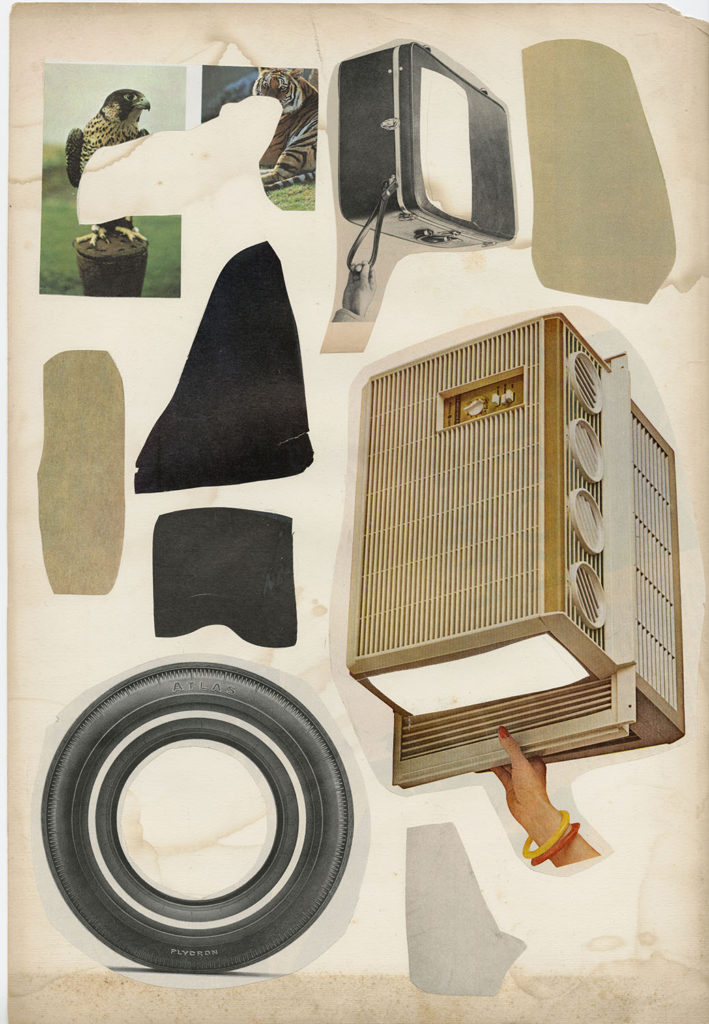Designer, artist and cut and paste maestro John Gall talks about his career and his latest book, Collages 2008-2018.

– You have recently published John Gall Collages 2008-2018, collecting work from the last ten years. Did the process of creating the book gave you another perception / perspective of your work?
I was approached by the Korean publisher, April Snow, about doing a book of my work. They did all of the heavy lifting, the design, the printing etc. I supplied the work, helped with the image selection and answered some questions that were then used as the book’s text. It is always interesting to see what others see in the work and what they see as important as we are not always the best judges of our own work so there was some back and forth about that. I also wanted it to be as up to date as possible.
I don’t really think the book changed how I view my own work. There is a progression to it. I haven’t done very much work since the book came out (for various reasons) but part of that hurdle is trying to get past the idea that the book is some kind of capstone and how to move beyond there. Finding it kind of hard to get back to some of the problems I was working out since they are now cemented in print. The whole collage thing for me is an open ended exploratory process.

How do you feel your work has changed over the last decade?
My work has definitely evolved over that time period. I started making things just in reaction to my day job as a problem solving graphic designer. This then lead to some editorial and illustration projects which then pushed my personal work further towards non-linear, non-literal, non-surreal pieces. The entire approach has been a dialogue with picture making vs non-picture making, literal vs abstraction. So there is an arc that bends toward abstraction but it can bend back at any time.

– How do you feel collage has changed in this period of time? Do you think there has been any evolution/change in collage as a medium?
What has really changed is the perception of how many people are making collage and the access we all have to it. I can’t imagine there was a time in art history when more people were making collage (and a lot of it very good) than the present day. I also see lots of ideas that I have been working out being explored by others. I don’t know if this is good or bad yet. I am sure it is some of both.

– I read that back in the time you found in collage a way of addressing ways of expression that weren’t possible in design, forcing you into a process of “unlearning”. After all this years working with collage and incorporating it in your design work, which place does collage has now in your work/life?
Collage for me started as a way to step away from design thinking and get back to the notion of just “making”. A big challenge for me involved addressing the decisions used to make something “look good”. As a designer we generally have to make something that has visual appeal in some shape or form—and this is learned behavior. I felt it necessary to challenge these predisposed ways of thinking as it became very limiting. “My mind is telling me to do this, so I should try do that instead”. Hence the “unlearning” aspect.
I started collaging as a way to broaden my design vocabulary but it has evolved into something that exists entirely on its own with its own set of rules and parameters. It’s an entirely different language.

– Your collage style is very personal and unique. How important is source material in your work (can you work with anything, or you spend time selecting what material you’re going to process)? Or does composition / color work is the main element that forms your identity as artist?
Collage as an art form is pretty basic and requires very little in terms of technical skill and tools. So every component becomes extremely important and I like to approach each of them very carefully. There is the source material, the cutting, the arranging, and the gluing.
I only use source material of little or no value. It just makes for a less pressurized situation. If I am traveling I like to work with only material I find in that setting. It could be stuff I find in a hotel lobby or a bookstore or a convenience store. I have stacks of old books and magazines that I get really cheap.
Cutting is crucial. The tools you use inform how you cut, and deciding what you cut is everything. I tend to focus on the empty spaces and not the obvious stuff. As far as arranging the layout goes, I employ many different methods in order to tweak my rational thought process. I might divide the paper up into different sections, I might glue the things down in the order I cut them out, I might arrange according to any number of organizational methods (including intuitive and conceptual) in order to get at something that I could not have imagined making. Some people are very into the gluing aspect. I just use a glue stick for the most part. I see myself as constantly breaking down what a collage can be and building it back up again.

– You work for the NYT (and other clients) creating collage illustrations. How can you combine the speed of editorial illustration with the limitations of handmade collage?
Most of the commissioned illustration work I do is now mostly digital. I do pull from handmade exploratory work and incorporate some of these elements—these things feed of of each other. But it is just not possible to do this work by hand since one has to be able to make changes on the fly. I also have ways of making it look handmade.

– Why do you feel collage is so appealing for designers?
Because at a certain level graphic design is also collage. Sure in the bigger picture a designer is selling and idea and a thought process and structural communication components, but a lot of design: book covers, posters, record covers etc is basically a collaging process that includes typography as one of the collage components.







Buy John Galle. Collages 2008-2018





